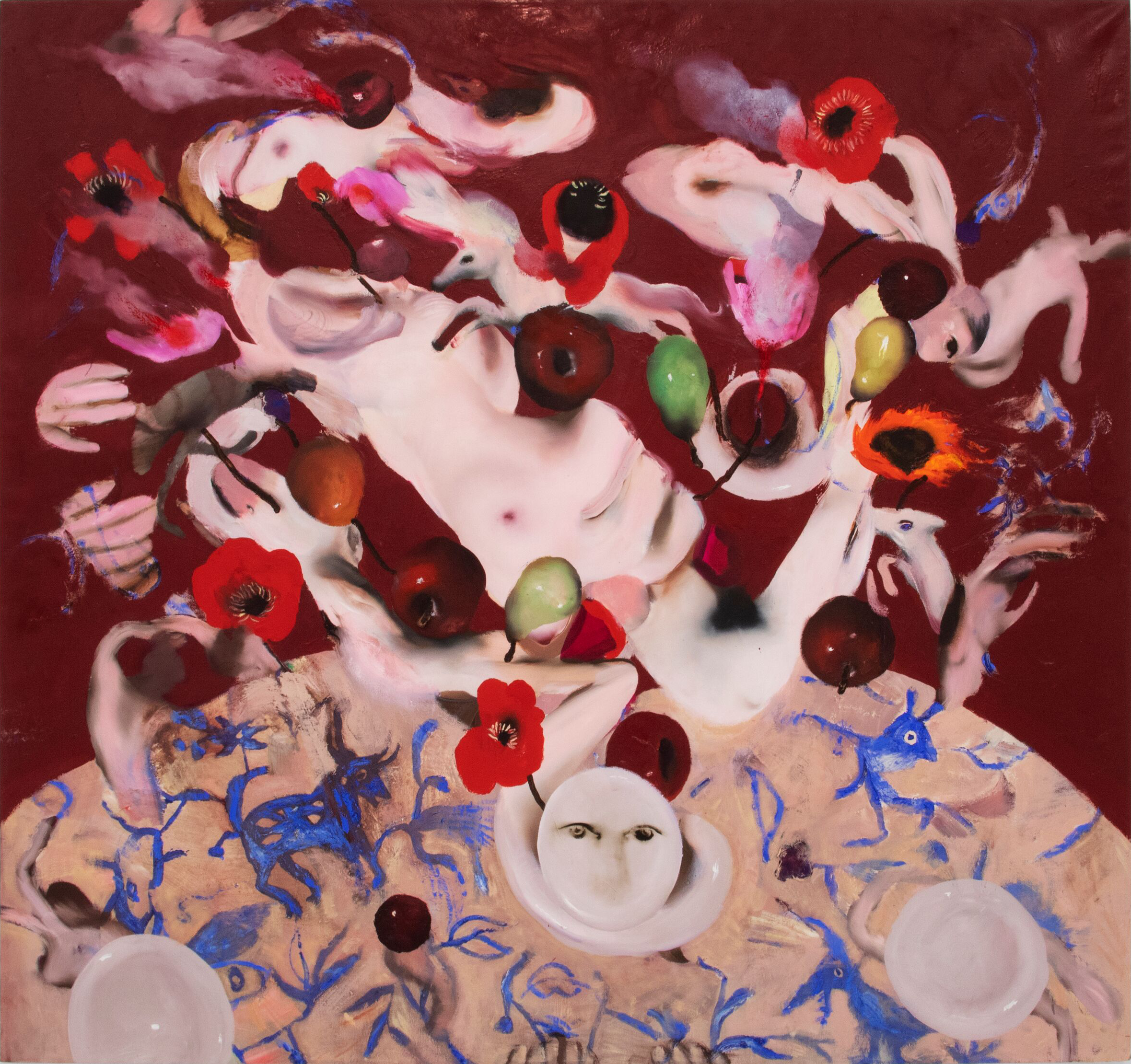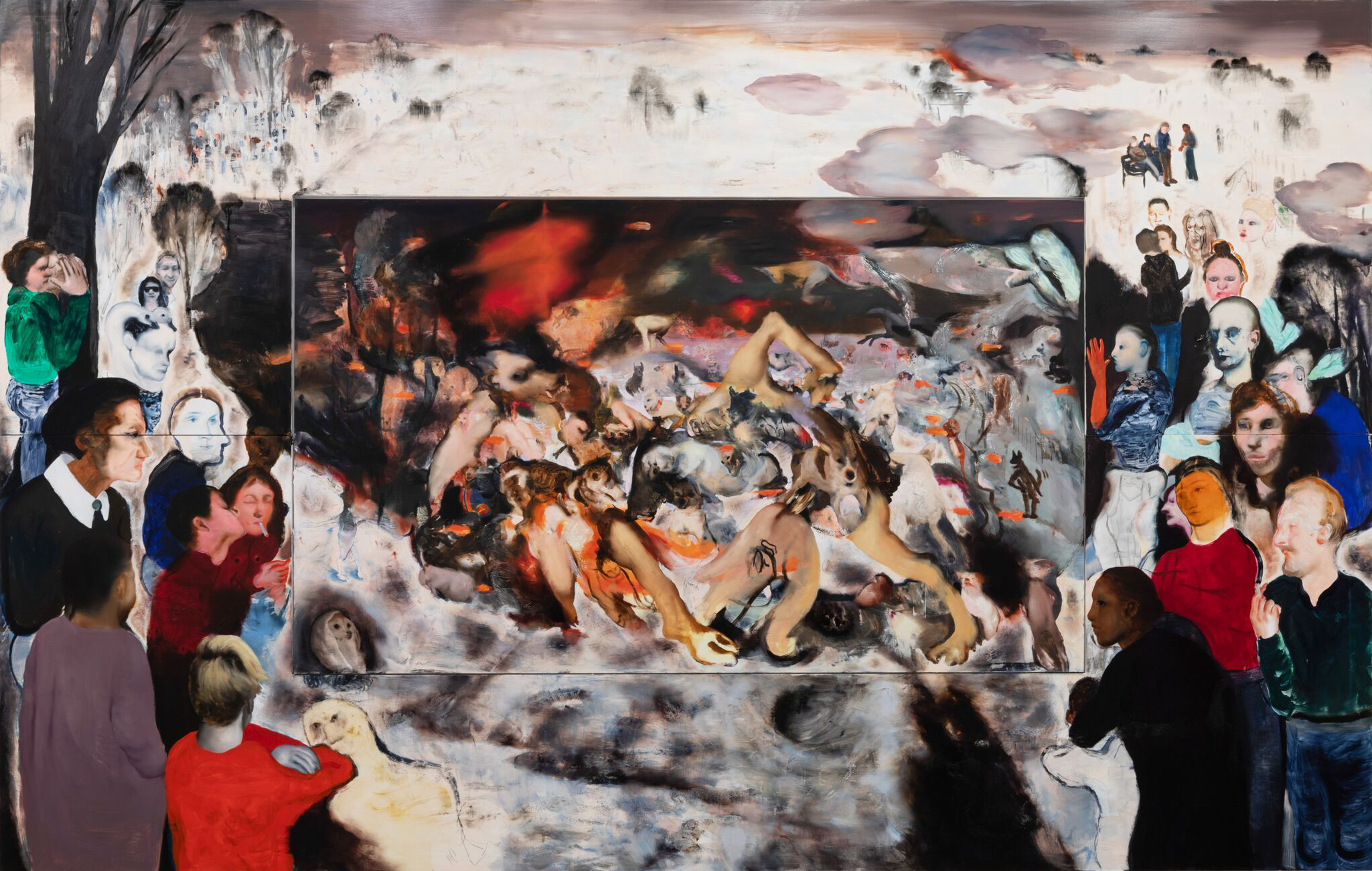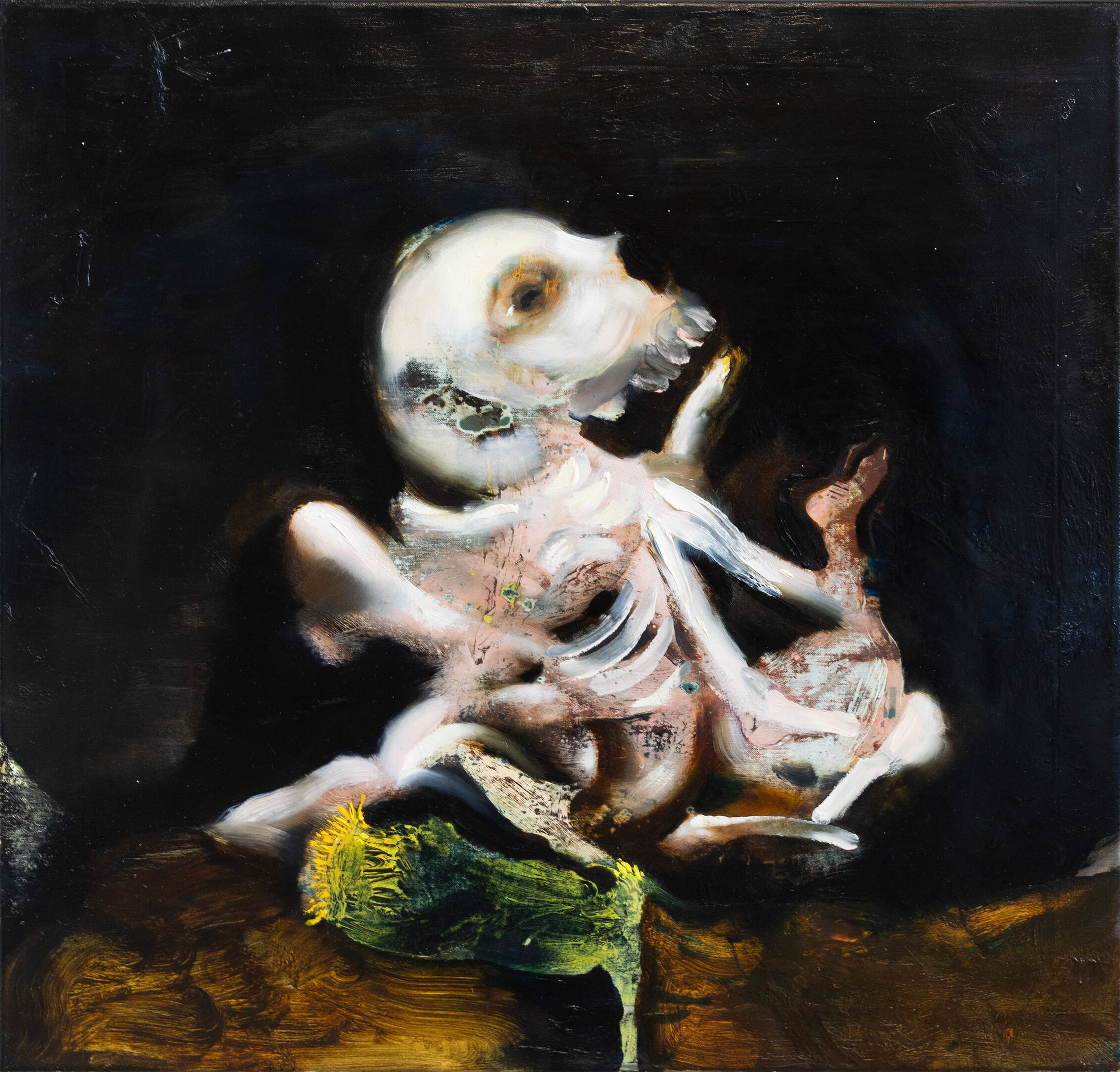Welcoming Ambera Wellmann to Hauser & Wirth in Partnership with Company Gallery, New York

Photo: Christian DeFonte
Welcoming Ambera Wellmann to Hauser & Wirth in Partnership with Company Gallery, New York
We are pleased to announce representation of Nova Scotia-born, New York-based artist Ambera Wellmann, in joint partnership with Company Gallery, NY. Wellmann has attracted international critical approbation for paintings that depict worlds within worlds, populated by human and animal forms emerging from and dissolving into each other and the atmosphere.
Rendered in oils with a technical dexterity that recalls the work of Renaissance and Baroque masters, her canvases are filled with unanchored figures and disembodied faces, shimmering swaths of illumination and darkness, anachronistic details and indeterminate spaces that circle and move in defiance of hierarchy, pointing instead to metamorphosis, vulnerability and collectivity as subjects. In their refusal of familiar typologies and binaries, Wellmann’s apparitions exist in a space where multiple contradictory experiences happen at once—the violent and the tender, carnal and spiritual, abject and transcendent, and the simply inexplicable—at the threshold of a future in which viewers are compelled to imagine themselves as participants.
In January 2024, Hauser & Wirth will present new work by Wellmann as a highlight of its stand at the tenth annual edition of FOG Design + Art in San Francisco (18 – 21 January). The gallery’s first major solo exhibition with the artist will open to the public in Fall 2024 at Hauser & Wirth’s Soho space on Wooster Street in New York City, complemented by a simultaneous solo exhibition at Company’s nearby location on Elizabeth Street. In September 2024, Wellmann also will be a featured artist of the 15th Gwangju Biennale exhibition ‘PANSORI—a soundscape of the 21st century,’ curated by Nicolas Bourriaud.

Ambera Wellmann, Séance Etiquette, 2020 © Ambera Wellmann. Courtesy the artist, Hauser & Wirth and Company Gallery

Ambera Wellmann, Orbit, 2022 © Ambera Wellmann. Courtesy the artist, Hauser & Wirth and Company Gallery
Through our joint partnership to represent Wellmann, Hauser & Wirth and Company are undertaking a collective impact approach—a model for a new kind of alliance between galleries of different scales in which full transparency and the sharing of resources can support both artists’ careers and the ongoing health of the wider gallery field itself.
‘We are thrilled to welcome Ambera Wellmann to Hauser & Wirth and to collaborate in equal partnership with Company in advancing the career of an artist we admire so deeply,’ says Marc Payot, President at Hauser & Wirth. ‘Ambera possesses a remarkable combination of skills—she is an astonishing technician, expert in the prerogatives and effects of art historical movements—which she deploys to create visual poetry that’s both magnetic and unsettling. She’s willing to untether herself and us from the familiar, to picture a more complete human experience of the body and beyond it to the province of the spirit. In her fearlessness and radicality, Ambera is aligned with many artists in our program, from such historical predecessors as Maria Lassnig, Philip Guston, Louise Bourgeois and Mike Kelley, whose essay ‘The Uncanny’ she describes as a critical influence, to contemporaries like Berlinde de Bruyckere and Allison Katz. It’s an honor to join forces with an artist and a gallery who are each known for their courage and originality.’
‘Since founding Company Gallery, my focus has been on redefining the traditional gallery model,’ explains Sophie Mörner, Founder, Company. ‘In line with this vision, we’ve cultivated an ethos that binds us closely with our artists. When Marc and I delved into discussions about Ambera, we shared a common interest in exploring innovative approaches to supporting an artist’s career. Our numerous conversations have led to the development of a collaborative partnership that aims to provide the optimal platform for Ambera. Within Company’s artist community, Ambera plays a significant role—her work being both radical and fierce, pushing the boundaries of painting. I am excited about this ongoing collaboration and am looking forward to what the future holds.’

Ambera Wellmann, Counterclockwise, 2022 © Ambera Wellmann. Courtesy the artist, Hauser & Wirth and Company Gallery

Ambera Wellmann, to a Girl in a Garden, 2023 © Ambera Wellmann. Courtesy the artist, Hauser & Wirth and Company Gallery
About the artist
Ambera Wellmann was born in 1982 in the port town of Lunenberg, Nova Scotia. She received her undergraduate degree from the Nova Scotia College of Art and Design in Halifax and studied at Cooper Union in New York. In 2016, while pursuing a master’s degree at the University of Guelph in Ontario, she received the Joseph Plaskett Award in Painting, which allowed her to live and work in Berlin.
In 2017, Wellmann won the prestigious RBC Canadian Painting Competition for work that explored many of the themes and methods she continues to pursue today in paintings constructed from numerous layers of intricately worked wet oils, often depicting nebulous human and animal forms, sometimes in extremis or entwined in states of ecstasy, figurative in only a tenuous sense. ‘I am often just looking for an arrangement with the bodies that actually feels impossible,’ Wellmann says, ‘in order to create a diagram for what kind of infinite possibilities the body can have.’
Wellmann’s work accrues through what she has described as a visual version of catachresis, the process in which a word is deliberately deployed incorrectly; her ‘painterly catachresis’ manifests through irrational pictorial space and the depiction of an indeterminate number of bodies, genders, species, all without any predetermined visual hierarchy. Wellmann’s art thus occurs at the frontier where the known meets the uncanny, ‘the moment in which things become impossible, either figuratively or spatially, but which still register in a way that makes formal sense,’ she explains. ‘This uncertainty is a form of intimacy (something unrecognizable is, oddly, the place in which we can recognize ourselves the most).’
While living in Berlin, Wellmann became more deeply engaged in art history. The influence of Goya, Bosch, Bruegel, Courbet and Ingres, as well as Italian Renaissance, Netherlandish and Spanish Baroque masters, emerged more palpably in her paintings through an increasingly deft command of illusory space and form. In addition to historical precedents, Wellmann draws from sources as diverse as pornographic photography and video, screenshots from Instagram and other digital sources, and observational drawings she made on the streets or in the subway.
Following her time in Berlin, Wellmann lived and worked in Mexico City. Pronounced floral imagery of her earlier paintings gave way to darker tableaux in which, as she has described it, ‘humans become animalized and animals humanized.’

Ambera Wellmann, Strobe, 2021 © Ambera Wellmann. Courtesy the artist, Hauser & Wirth and Company Gallery
A more ominous atmosphere evolved in her canvases, with movement taking place against spectral, foreboding plains that echo El Greco, de Chirico and Tanguy. In some paintings, skeletal forms began to appear as central figures. Erasure, often accomplished with the use of an electric sander, became more integral to Wellmann’s finished work during this time. For her, erasure is a process through which to slow the viewer’s eye and ‘involve them in the time of the painting and its making.’ It permits her to create uncertain space-time coordinates and render realms where past and present, human and animal bodies, undergo transmutation. By thus embracing chance, error and revision, she exposes the processes of metamorphosis, positing the vulnerability of the individual as the path to collectivity.
In 2021, Wellmann’s tour de force work ‘Strobe’ debuted as a centerpiece of the New Museum’s Triennial exhibition ‘Soft Water Hard Stone,’ curated by Margot Norton and Jamillah James. At thirty feet wide, this vast canvas depicts a landscape strewn with forms that suggest windblown limbs, clouds, detritus and elongated figures of radically different sizes, as well as frolicking dogs and miniature girls smoking cigarettes, all anchored by a top- down view of a faucet-less sink, its gleam referencing a trope Wellmann employed in earlier work by creating trompe l’oeil reflections of light on porcelain. Of the painting, she says, ‘you have to experience it in fragments, so it never reaches any kind of resolution.’
With ‘Strobe,’ Wellmann established a new benchmark in her practice, collapsing and reconfiguring ground that is neither liquid nor solid, and light that is neither dawn nor dusk, to assert a vision of the future.
In April 2023, Wellmann’s exhibition ‘Antipoem’ opened at the Fondazione Sandretto Re Rebaudengo in Turin. Her new works on view took as a point of origin Anne Carson’s 2002 translations of ‘Sappho, If Not Winter,’ a book that became a preoccupation of Wellman’s chiefly because of the incomplete, highly scattered nature of Sappho’s surviving verse. ‘The absence of language becomes a space that the reader or the viewer can imagine and insert themselves into and occupy that space more intimately,’ Wellmann says, adding: ‘That becomes a fruitful space from which to make paintings.’ Among the new ‘Antipoem’ paintings were a series of large-scale works that explored themes of fear, power and formlessness through a critical confrontation with the art historical motif of the Minotaur. Set amid nocturnal landscapes, Wellmann’s figures obscured and dissolved in their environments, where darkness functioned as both a metaphor for vulnerability and a limitless queered atmosphere in which the boundaries of the body could disappear.
In describing her work, noted curator and critic Nicolas Bourriaud has said that Wellmann ‘does not represent bodies, but the circumstances of their disappearance into the fluidity of the world,’ positing that her artistic endeavor ‘poses a crucial question: how is energy distributed? And how can art make this atlas of energies visible, tangible, usable by each and every one of us?’
Wellmann’s work has been exhibited at numerous museums and foundations internationally, including Fondazione Sandretto Re Rebaudengo, Turin (2023); Stavanger Art Museum, Norway (2023); ICA Boston (2022); Palazzo Bollani, Venice (2022); the New Museum, New York (2021); Staatsgalerie Stuttgart, Germany (2021); MAC Belfast, UK (2021); Pond Society, Shanghai (2021); The Columbus Museum of Art, Columbus OH (2021); MoCO, Montpellier (2019); MoMA Warsaw, Poland (2019); Australian Center for Contemporary Art, Melbourne (2019); and Palais de Tokyo, Paris (2019).
Her work resides in the permanent collections of the National Gallery of Canada, Ontario; Museum of Fine Arts, Boston; Kistefos Museum, Jevnaker; Fondazione Sandretto Re Rebaudengo, Turin; the Philara Collection, Dusseldorf; the Aïshti Foundation, Beirut; The Columbus Museum of Art, Columbus OH; ICA Miami; Mudam Luxembourg in Luxembourg; and the X Museum, Beijing.
About Hauser & Wirth’s new collective impact initiative
Since its founding in 1992, Hauser & Wirth has been committed to business innovation in support of artists. In this spirit, the gallery is undertaking a new initiative focused upon collective impact: a model for joint artist representation in full partnership with galleries operating at different scales. Characterized by full transparency and intensive resource sharing, these alliances are envisioned as means to contribute to both the development of artists’ careers and the future health of the wider gallery ecosystem. In this collective impact model, each gallery partnership will be tailored to the needs of the specific artist jointly represented, informed by mutual dedication to artists’ voices and public engagement.
Related News
1 / 5




